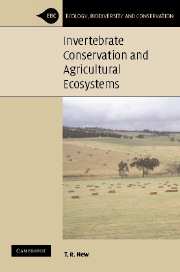Book contents
- Frontmatter
- Contents
- Preface
- Acknowledgements
- 1 Introduction: agricultural ecosystems and conservation
- 2 Agriculture and biodiversity: the place of invertebrates
- 3 Agriculture: effects on invertebrate diversity and conservation
- 4 Agricultural disturbance: diversity and effects on invertebrates
- 5 Biological control and invertebrate conservation
- 6 Cultural aspects of pest management
- 7 Extending beyond cropping areas
- 8 Field margins and landscape ecology
- 9 Pasture management and conservation
- 10 Towards more holistic management for invertebrates
- References
- Index
5 - Biological control and invertebrate conservation
Published online by Cambridge University Press: 29 July 2009
- Frontmatter
- Contents
- Preface
- Acknowledgements
- 1 Introduction: agricultural ecosystems and conservation
- 2 Agriculture and biodiversity: the place of invertebrates
- 3 Agriculture: effects on invertebrate diversity and conservation
- 4 Agricultural disturbance: diversity and effects on invertebrates
- 5 Biological control and invertebrate conservation
- 6 Cultural aspects of pest management
- 7 Extending beyond cropping areas
- 8 Field margins and landscape ecology
- 9 Pasture management and conservation
- 10 Towards more holistic management for invertebrates
- References
- Index
Summary
Pest control by use of ‘natural enemies’ is the basis for biological control, which may involve the introduction and release of exotic predators and parasites of pests, or enhancement of naturally occurring species that fulfil these roles. Concerns over the former (classical biological control) involve the invasive effects of such introduced species to attack native, non-target biota, and have led to development of convincing protocols to help affirm their specificity (and, hence, safety) in their new environment. Many of the concerns of conservationists over biological control devolve on the difficulties of predicting what introduced species may do after release.
Introduction
Biological control involves the use and manipulation of the so-called ‘natural enemies’ of pests (that is, most frequently, their predators, parasitoids and pathogens) in the management of those pests. It was developed largely as the major alternative or complementary strategy to insecticide use, and earlier work involved predominantly ‘classical biological control’ (CBC). This approach dealt with the numerous cases in which the pest (usually an arthropod, and most commonly an insect) is exotic (that is, it has been introduced or arrived naturally but is non-native) to the area in which it causes damage, and that high levels of abundance and invasibility resulted – at least in part – because it is no longer regulated by the complex of associated natural enemies that are associated with it within its natural area of distribution and evolution.
- Type
- Chapter
- Information
- Invertebrate Conservation and Agricultural Ecosystems , pp. 138 - 188Publisher: Cambridge University PressPrint publication year: 2005



